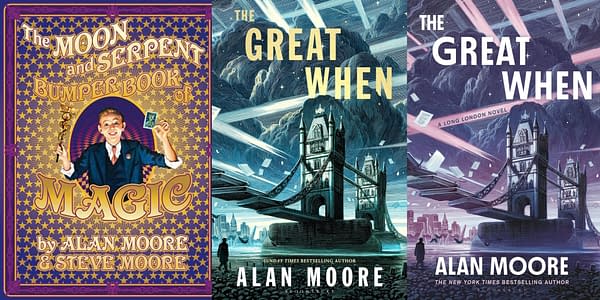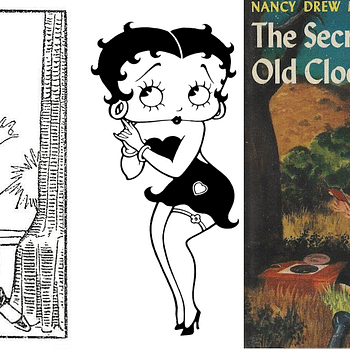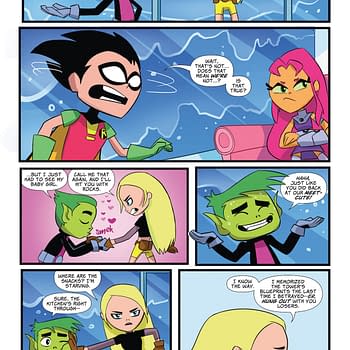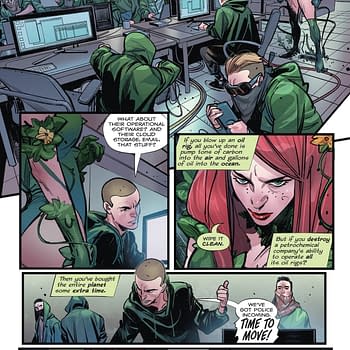Posted in: Comics, Current News | Tagged: Alan Moore, guardian
Alan Moore Talks Dangers and Delights of Comics Fandom to The Guardian
Alan Moore talks about both the dangers and the delights of comics fandom, and beyond, to The Guardian newspaper
Article Summary
- Alan Moore discusses fandom's dual nature: enriching culture yet fueling toxicity.
- Revisiting 1960s comics scene reveals Moore's early conflicts with fandom's obsessions.
- Moore shares insights on fandom aging, gentrification, and creative stagnation.
- Explore the intrigue in Moore's Long London series and The Moon and Serpent Book.
When Bleeding Cool revealed the name of the second of Alan Moore's Long London novels, on the week that the first was released, we stated "Then there will be the inevitable Guardian article about Alan Moore and superheroes, reviews in The Times newspaper. and plenty of the usual kinds of headlines that will spill out." And this weekend, our prophecy came true, with an opinion piece by Alan Moore in the Guardian, headed (out of the control of the author) "'Fandom has toxified the world': Watchmen author Alan Moore on superheroes, Comicsgate and Trump". I mean, he doesn't talk a lot about them, but there is a brief mention. As he begins,
"About a decade ago, I ventured my opinion that the adult multitudes queueing for superhero movies were potentially an indicator of emotional arrest, which could have worrying political and social implications. Since, at that time, Brexit, Donald Trump and fascist populism hadn't happened yet, my evidently crazy diatribe was largely met with outrage from the fan community, some of whom angrily demanded I be extradited to the US and made to stand trial for my crimes against superhumanity – which I felt didn't necessarily disprove my allegations."
Alan Moore has often been caricatured as an embittered, angry old hermit shouting at clouds, which studiously ignores that he often engages in self-deprecation through self-aggrandisement, asking the reader how someone could possibly hold such views before pulling away the rug he is perched upon. Generally, I have found him to be a man of good cheer, and when it comes to superheroes, his daughter Leah Moore elaborated a lot. But he does clarify his views a little,
"Ten years on, let me make my position clear: I believe that fandom is a wonderful and vital organ of contemporary culture, without which that culture ultimately stagnates, atrophies and dies. At the same time, I'm sure that fandom is sometimes a grotesque blight that poisons the society surrounding it with its mean-spirited obsessions and ridiculous, unearned sense of entitlement."
He also adds his earliest experiences with sixties comics fandom, taking the trip from Northampton to London.
"Quite liking comics, aged 14 I thus became a comics fan with my discovery of British fandom, which was then still gummy-eyed and fresh out of the egg. The first convention I attended in London, in the basement rooms of a Southampton Row hotel in 1969, was tiny and inspiring. The attenders barely totalled a three-digit number, almost all of them some few years short of legal drinking age. The comics companies, having no monetary interest in a handful of penniless teenagers, went blissfully unrepresented, and the only industry celebrity that I recall was the sublime and sweetly unassuming genius Frank Bellamy, passing Dan Dare or Garth originals around, appearing wonderstruck that anyone had heard of him. The only thing uniting the assembly was its passion for an undervalued storytelling medium and, for the record, the consensus verdict of the gathered 15-year-old cognoscenti was that costumed musclemen were the main obstacle preventing adult audiences from taking comics seriously."
Frank Bellamy, six or seven years before his death then, was best known for his groundbreaking work on the weekly Eagle comic, drawing Heros the Spartan, Fraser of Africa and, of course, Dan Dare. He also drew Thunderbirds for the weekly comic TV Century 21 and the sci-fi action adventure newspaper strip Garth for the Daily Mirror from 1971 until his death in 1976. So maybe not originals in 1969. Have I just fact-checked Alan Moore? This feels so wrong. But he also described a scene which wasn't so different from the London scene I first discovered in the eighties at a similar age.
"Of that hardly-a-hundred schoolkids, office boys and junior librarians, the great majority were actively involved in their pursuit, publishing or contributing to a variety of – for the most part – poorly duplicated fanzines, or else going on to work professionally in the field, such as Kevin O'Neill, Steve Moore, Steve Parkhouse or Jim Baikie, all of whom were downstairs at the Waverley hotel that weekend, keen to elevate the medium that they loved, rather than passively complain about whichever title or creator had particularly let them down that month. Of course, this was the 1960s and the same amateur energy seemed to be everywhere, spawning an underground press, Arts Lab publications and a messy, marvellous array of poetry or music fanzines that were the material fabric of that era's counterculture; flimsy pamphlets as important and innovative today as they were then, although considerably more expensive, trust me."
However, it was around the time I discovered the UKCAC shows in Bloomsbury, London, that Alan Moore swore off conventions after being pursued for an autograph under the toilet stall door. As he describes;
"I detected the beginnings of a tendency to fetishise a work's creator rather than simply appreciate the work itself, as if artists and writers were themselves part of the costumed entertainment. Never having sought a pop celebrity relationship with readers, I withdrew by stages from the social side of comics, acquiring my standing as a furious, unfathomable hermit in the process. And when I looked back, after an internet and some few decades, fandom was a very different animal."
I'd love to hear Alan talk more about his disconnect from himself and the pop culture caricature of him, which I have found lacking in the few moments I've met the man.
"An older animal for one thing, with a median age in its late 40s, fed, presumably, by a nostalgia that its energetic predecessor was too young to suffer from. And while the vulgar comic story was originally proffered solely to the working classes, soaring retail prices had precluded any audience save the more affluent; had gentrified a previously bustling and lively cultural slum neighbourhood. This boost in fandom's age and status possibly explains its current sense of privilege, its tendency to carp and cavil rather than contribute or create. I speak only of comics fandom here, but have gained the impression that this reflexive belligerence – most usually from middle-aged white male conservatives – is now a part of many fan communities. My 14-year-old grandson tells me older Pokémon aficionados can display the same febrile disgruntlement. Is this a case of those unwilling to outgrow childhood enthusiasms, possibly because these anchor them to happier and less complex times, who now feel they should be sole arbiters of their pursuit?"
Something else that may have passed Alan Moore by, naturally, is the rise of Webtoon comic books, free to readers with the kind of device that every schoolchild has manages to get these days. And remarkably popular, bypassing class boundaries of income. As well as comic books being stocked in depth in high school libraries, a fantasy when we were kids. That gives me much hope for the future of the medium… given the chance. Anyway, all this comes alongside the release of The Great When and The Moon And Serpent Bumper Book Of Magic this month. To be followed by I Hear A New World in 2026.
The Great When: A Long London Novel Hardcover – Bloomsbury USA. From the New York Times bestselling author and legendary storyteller Alan Moore, the first book in an enthralling new fantasy series about murder, magic, and madness in post-WWII London. Dennis Knuckleyard is a hapless eighteen-year-old who works and lives in a second-hand bookstore. One day, his boss and landlady, Coffin Ada, sends him to retrieve some rare books, one of which, Dennis discovers, should not exist. A London Walk by Rev. Thomas Hampole is a fictitious book that appears in a real novel by another author. Yet A London Walk is physically there in his hands, nonetheless. Coffin Ada tells Dennis the book comes from the other London, the Great When, a version of the city that is beyond time. In the Great When, epochs blend and realities and unrealities blur, while concepts such as Crime and Poetry are incarnated as wondrous and terrible beings. But, Coffin Ada tells Dennis, if he does not return the book to this other London, he will be killed. So begins Dennis' adventure in Long London. Delving deep into the city's occult underbelly and tarrying with an eccentric cast of sorcerers, gangsters, and murderers, Dennis finds himself at the center of an explosive series of events that may endanger both Londons. Mystical, hilarious, and magnificently imagined, The Great When is an unforgettable introduction to the consciousness-altering world of Long London.
The Great When: A Long London Novel Hardcover –Bloomsbury UK. A dark and beguiling tour through the streets of a magical London by the Sunday Times bestselling master of modern fantasy, Alan Moore. The year is 1949, the city London. Dennis Knuckleyard is a hapless eighteen-year-old who works and lives in a second-hand bookstore. One day, on an errand to retrieve rare books, Dennis discovers that one of them does not exist. It is a fictitious book, yet it is physically there in his hands nonetheless. How? It comes from the Great When, a dark and magical version of the city that is beyond time. There, epochs blend and realities and unrealities blur. If Dennis does not take this book back to the other London, he will be killed. So begins a journey delving deep into the city's occult underbelly and tarrying with an eccentric cast of sorcerers, gangsters, and murderers, many of whom have their own nefarious intentions. Soon Dennis finds himself at the center of an explosive series of events that may alter and endanger both Londons. Mystical, magnificently written and hilarious, The Great When is Moore's most imaginative work yet and the first in the fantastic new Long London series.
The Moon and Serpent Bumper Book of Magic Hardcover – Knockabout UK
The Moon and Serpent Bumper Book of Magic Hardcover – Top Shelf USA
Splendid news for boys and girls, and guaranteed salvation for humanity! Messrs. Steve and Alan Moore, current proprietors of the celebrated Moon & Serpent Grand Egyptian Theatre of Marvels (sorcery by appointment since circa 150 AD) are presently engaged in producing a clear and practical grimoire of the occult sciences that offers endless necromantic fun for all the family. Exquisitely illuminated by a host of adepts including Kevin O'Neill, Melinda Gebbie, John Coulthart, José Villarrubia and other stellar talents (to be named shortly), this marvelous and unprecedented tome promises to provide all that the reader could conceivably need in order to commence a fulfilling new career as a diabolist.
Its contents include profusely illustrated instructional essays upon this ancient sect's theories of magic, notably the key dissertation "Adventures in Thinking" which gives reliable advice as to how entry into the world of magic may be readily achieved. Further to this, a number of "Rainy Day" activity pages present lively and entertaining things-to-do once the magical state has been attained, including such popular pastimes as divination, etheric travel and the conjuring of a colourful multitude of sprits, deities, dead people and infernal entities from the pit, all of whom are sure to become your new best friends.
Also contained within this extravagant compendium of thaumaturgic lore is a history of magic from the last ice-age to the present day, told in a series of easy-to-absorb pictorial biographies of fifty great enchanters and complemented by a variety of picture stories depicting events ranging from the Paleolithic origins of art, magic, language and consciousness to the rib-tickling comedy exploits of Moon & Serpent founder Alexander the False Prophet ("He's fun, he's fake, he's got a talking snake!").

















